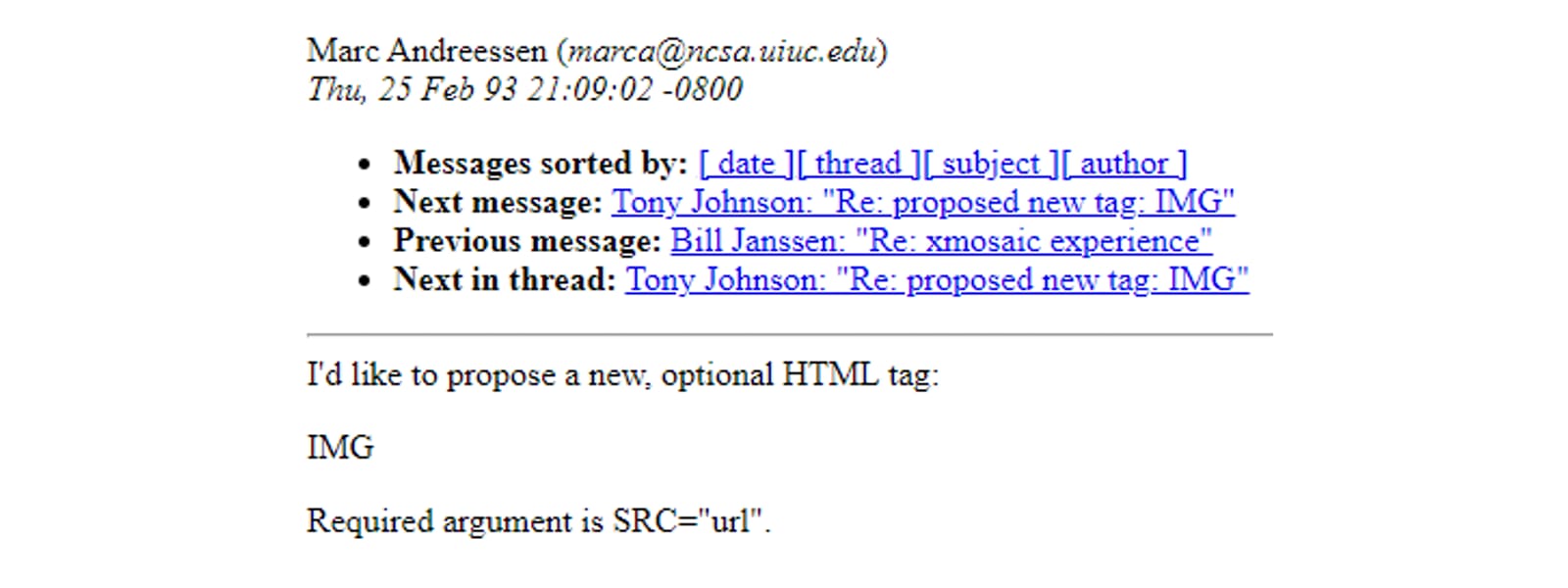Let There Be Images

Weil dieses Mal sowohl Deepl als auch Google Translate ziemlichen Unsinn produzieren, habe ich den folgenden Artikel für meine deutschsprachigen Leser selbst übersetzt: »Bilder« (PDF, 77 kB).
It’s thirty years now that Marc Andreessen came up with the idea to extend HTML by a means to add images to a web page. Or to put it with some pathos: he opened up the road that led from a purely textual internet into the realm of multimedia and thus, in the long run, he helped to greatly increase the appeal of the World Wide Web to a general audience far beyond the circles of nerds and specialists.
It’s only thirty years – and yet: reading Andreessen’s message (and considering its humble, plain layout) feels like marvelling at an artifact from a distant past, a silent movie, say, or a punched card.
But how much worse off were our past selves or – through the eyes of younger readers – our parents and grandparents back then in 1993, for having no internet or an internet without images (and, for that matter, without audio and video, without live streaming, without cloud storage, without wireless high-speed communication, without smartphones, and without all those services and helpers we use every day)?
We’d rather not do without all this, right? Plan our travel route using an unwieldy folding map? Look up a word in a tome, heavy as three bricks, that we have to pull out of the book shelf? Actually meet our friends in real life to show them a photo of that funny thing that just happened or, more probably, to recount it in our own words (for who the heck did always carry a camera in those pre-smartphone times?). – And hey: who could possibly want this blog to be text-only?
So, question answered: clearly, we do want images on the web and all the other stuff and bells and whistles, too!
How about the first question? How much worse off were our younger selves? Or rather: what did (and still does) it cost us to have all these things that our younger selves didn’t have? What’s the price that we pay in hard, if intangible, currency – in psychological and physiological, in social and in cultural valuta? Is there some point when we started to pay more than we get?
Tricky to figure, but I have a hunch that the balance might not be quite as rosy as we assume.
P.S.: Just to give names to some items on the invoice – I’d mention increased polarisation of society; reduced span of attention; cyber mobbing; wasting a terrifying amount of irreplaceable life time on obsessive, zombie-like pseudo-activity (which is not the same as the wonderful state of leisurely idleness that I praise); increased competition on things like looks and popularity; believing that things are for free that are actually not free (you pay with your data); loss of the public, multifarious and egalitarian internet that we could have had in favour of an internet that consists of very few extremely big companies and their services (and it’s not the Zuckerbergs who are to blame, we users are the suckers) – oh, and next to these intangible points there may be some invoice items that could very well be expressed in terms of money, like the millions that all too many web design companies earned by selling snake oil and shiny, worthless bric-a-brac to their credulous customers. Think of »pixel-perfect websites«, which means websites that fit a screen design to the pixel and look identical to the pixel in every browser – a totally idiotic concept that, back in the noughties, cost hours and hours and hours of senseless pseudo-work for which said customers were billed (I know what I’m talking about because I was hired as a freelancer to do exactly this bullshit work, next to other much more useful tasks, happily). Or think of the similarly idiotic paradigm that every web page and every element on it has to fit some »grid«. A lot of work was wasted on thinking about if every measure – widths and heights and distances – on a web page must be divisible by 12 or rather 16 pixels, and on implementing those totally arbitrary and senseless »grids« (making sure that no element on a web page escapes it!). Again, customers paid for this quasi-religious mumbo jumbo. – But wait, I’m getting way too specific and nerdy here and must beg my readers’ pardon …!
P.P.S.: As for free things on the web that are not for free and as for the consequences, I’d like to refer you to the article »Nothing Fails Like Success« by Jeffrey Zeldman and »The ‘Enshittification’ of TikTok« by Cory Doctorow. And to German-speaking readers with an interest for the nerdy details of web development and some (strictly subjective) criticism of the one or other working practice, I’d like to recommend the collection of short articles that my friend Guido and I published some years ago: »ABC für Webmenschen«.